What's wrong with my plant? Strawberry plants and fruit
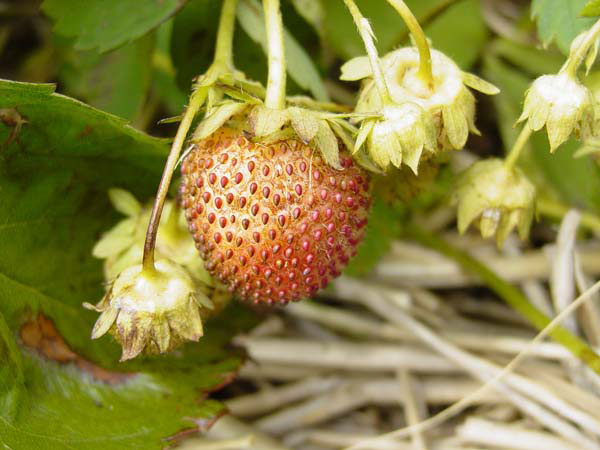
The content of this article 'What's wrong with my plant? Strawberry plants and fruit' was prepared by the University of Minnesota and has been revised and republished by FreshFruitPortal.com.
Today we are going to take a look at what is going on with your strawberry plants. Focusing on the fruit and the plant, strawberries aren't normally hard to keep healthy but when plagues and diseases take over it becomes a different story.
For the latest information, check the University of Minnesota's website here.
If you see discolored or rotten fruit
Gray Mold
Botrytis cinerea
- Fruit develops indistinct, soft, light brown spots that rapidly enlarge and have a mild rotten smell
- Gray powdery spores form on infected fruit under moist conditions
- Disease favored by wet conditions and temperatures between 41-86F
- One or several flowers in a cluster may turn brown to black and dry out
- Black discoloration may extend down into the flower stalk
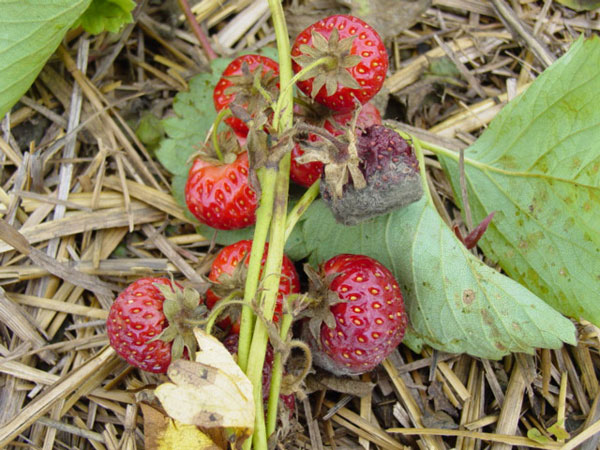
Sunscald/Heat Stress
- Berries are pink to bronze where directly exposed to sun
- Berries have a pleasant, wine smell
- Occurs in extreme heat at/near harvest
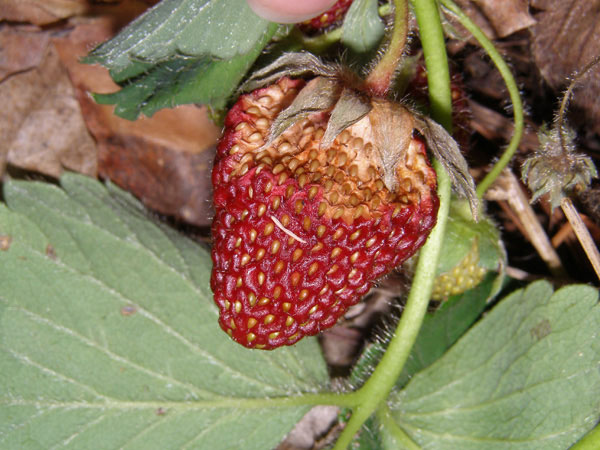
Spotted Winged Drosophila
Drosophila Suzukii
- Active in gardens from July to September
- Larvae feed on healthy, intact, ripening fruits
- Larvae feed within the berries causing brown, sunken areas
- Fruit becomes soft and decays
- Adult flies are small (1/8 - 1/12 inch) long, yellowish-brown and red eyes, larvae are small (1/8” long), white and cylindrical
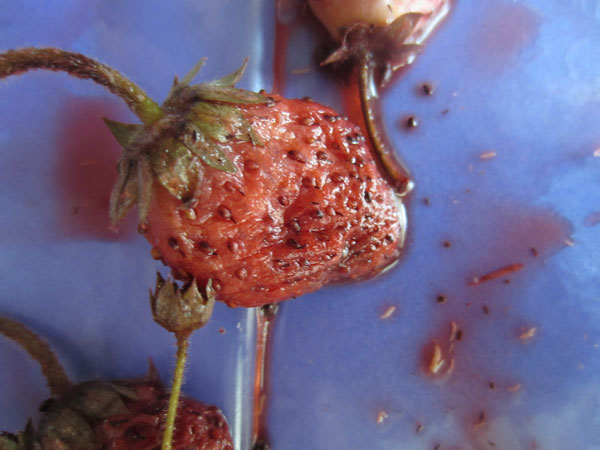
More information on Spotted Winged Drosophila
Flower Thrips
Frankliniella occidentalis
- Feeding by thrips results in a berry that has a bronzed appearance
- Thrips are very small insects (approximately 3/10 inch long) have feathery wings and vary in color from yellow to dark brown; nymphs are white or yellowish with small dark eyes
- Thrips are present in early spring

Leather Rot
Phytopthora cactorum
- A section of the berry or the entire fruit may turn tan, purple or brown
- Infected berries have a foul “chemical” odor and become tough, leathery
- Berries with any amount of infection are very bitter tasting
- Infects flowers, green fruit and ripe fruit
- Commonly occurs in low areas or where free standing water is present
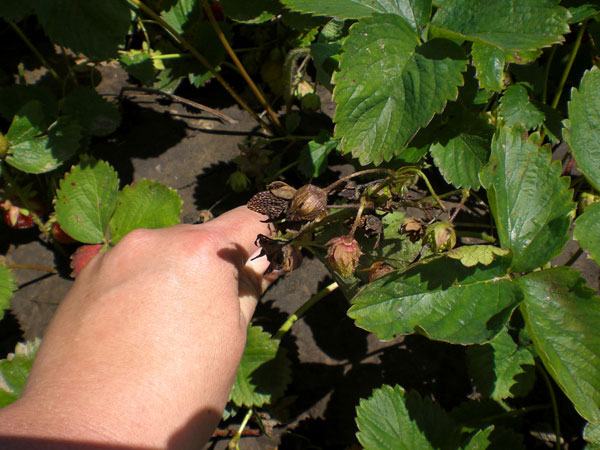
More information on Leather Rot
Anthracnose
Colletotrichum sp.
- Fruit will develop distinct round sunken brown to black blotches with no smell
- Wet pinkish orange sticky spores may form in the center of the fruit infection when wet
- Fruit rot can occur on green or ripe fruit
- Spots on leaves are small (<1/4"), round, sunken and gray-black, often resembling ink spots
- Flower infection results in dried out and brown flowers and flower stalks
- Occurs more frequently in very warm and humid weather (>80°F)

More information on Anthracnose
Leaf Blight
Phomopsis obscurans
- First see purplish red round leaf spots with a gray brown center
- Spots grow into a large V shaped lesion with a dry brown triangle in the center and a reddish purple V shaped border
- Elongated, sunken, purplish brown or reddish brown spots or streaks may be seen on stems
- Berries can develop soft pink-brown spots
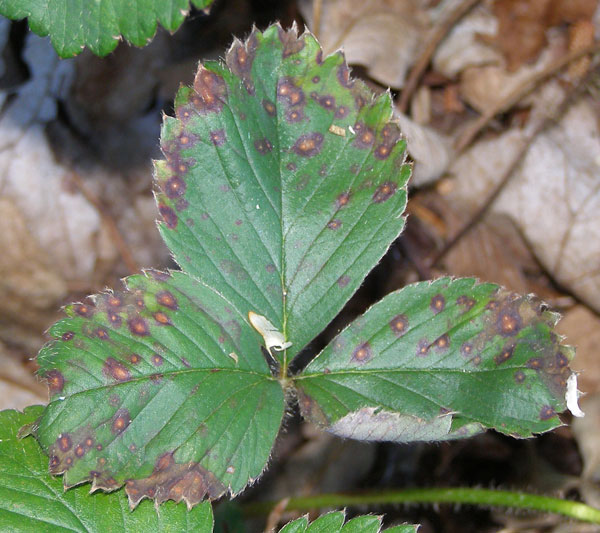
More information on Leaf Blight
If you see a wilting plant
Black Root Rot
Rhizoctonia sp. Pythium sp. and Fusarium sp.
- After first year, plants in a field showing reduced vigor, often in low or wet spots or in areas where the soil is compacted
- Roots appear ‘rat tailed’ and do not have fine fibrous root hairs
- Irregular black patches occur along the length of the fleshy white roots
- Interior of infected older woody roots turns black
- Common in areas where strawberries have been grown for many years
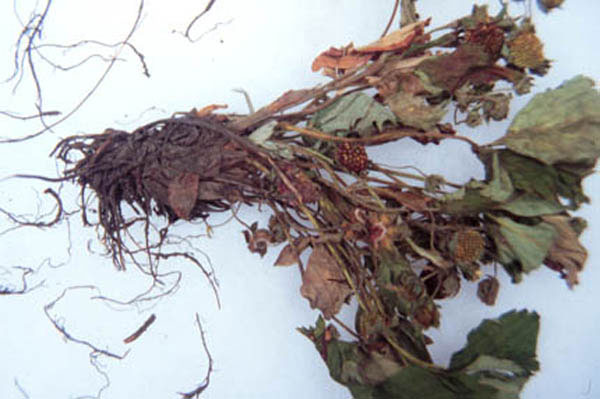
More information on Black Root Rot
Red Stele
Phytophthora fragariae
- Plants start wilting and dying in the lower portions of the strawberry planting
- Roots appear ‘rat tailed’ and do not have fine fibrous root hairs
- Root tips are soft, discolored and rotten
- If the white root above the rotten tip is cut lengthwise, the root core (or stele) will appear to be dark red
- Common and most destructive in heavy clay soils or low wet areas
- Favored by cool, wet spring weather
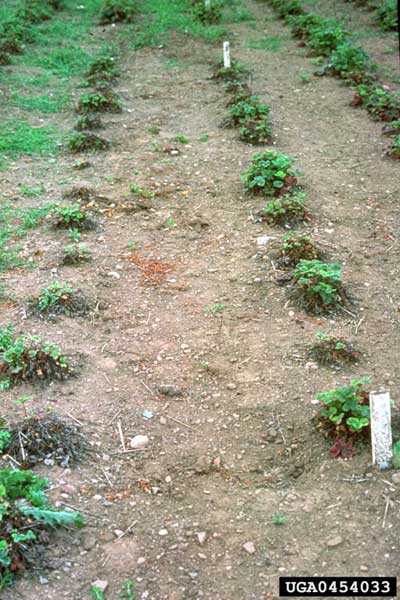
Verticillium Wilt
Verticillium albo-atrum or V. dahliae
- Outer and older leaves droop, wilt, turn dry and become reddish-yellow or dark brown at the margins and between veins
- In severe infestations rapid plant death can occur
- Severely infected plants may appear stunted and flattened, with small yellowish leaves.
- Brownish to blue-black streaks or blotches may appear on the runners or petioles
- More prevalent in cool, overcast weather interspersed with warm, bright days

More information on Verticillium Wilt
White Grubs
Phyllophaga spp.
- Plant is stunted, will wilt, and eventually dies
- Grubs feed on roots throughout the summer months
- Grubs have a white body color, brown head capsule, and c-shaped body
- Occurs in plantings that were previously grassy
- Adults do not feed on strawberries
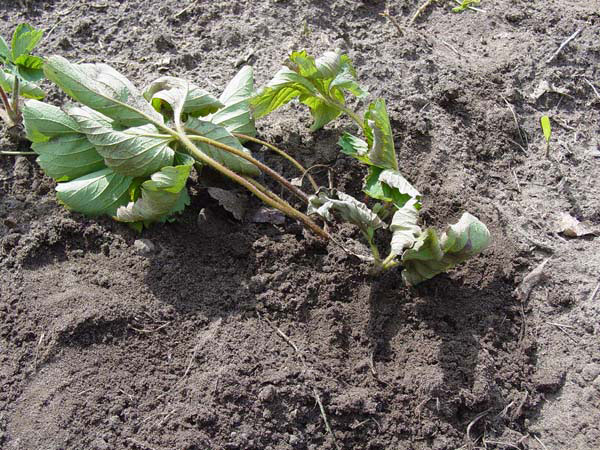
More information on White Grubs
Source: University of Minnesota








































